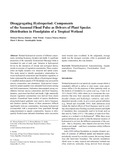Disaggregating hydroperiod: components of the seasonal flood pulse as drivers of plant species disribution in floodplains of a tropical wetland

View/
Date
2014-06-22Author
Murray-Hudson, Michael
Wolski, Piotr
Murray-Hudson, Frances
Brown, Mark T.
Kashe, Keotshephile
Publisher
Springer Link, http://link.springer.com/article/10.1007/s13157-014-0554-x#Type
Published ArticleMetadata
Show full item recordAbstract
Wetland hydroperiod consists of different components, including frequency, duration and depth. A significant proportion of the seasonally flood-pulsed Okavango Delta is inundated for part of each year. Variation in hydroperiod, driven by the interaction of climate and ecological factors, results in a mosaic of vegetation communities. These communities are highly dynamic over temporal and spatial scales. This study aimed to identify quantitative relationships between hydroperiod components and floodplain vegetation, to better understand the potential effects of hydrological change. A stratified randomsample of 30 floodplains was surveyed for species composition and abundance. Hydroperiod components for sample quadrats were estimated fromremote sensing and field measurement. Ordination demonstrated strong correlations between species composition and flood frequency, duration, years-since-last-flood and depth. Eight statistically discrete vegetation communities were derived from cluster analysis. Generalized linear models of species distributions along hydrological gradients were used to derive frequency and duration optima. Means of these parameters differed
significantly between communities. Increasing hydroperiod corresponded with a progression from grasslands through sedge-dominated to aquatic communities. Species in infrequently flooded areas indicated disturbance and a succession trend towards open woodland. In the sedgelands, average
depth was the strongest correlate, while in grasslands and aquatic communities, this was duration.
Collections
- Research articles (ORI) [270]
